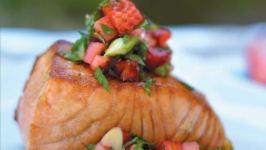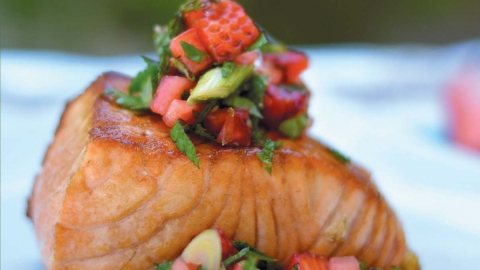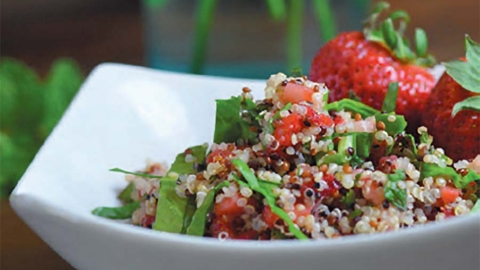Don’t Forget the ‘Sometimes’ Wild and Wonderful Strawberry
We’ve all heard the adage “an apple a day keeps the doctor away.” Although this colloquialism may hold some truth – apples are rich in antioxidants, flavonoids and dietary fiber – why should apples get all the glory?
Enter that bright, red, juicy strawberry. A strawberry a day may not keep the doctor away, but consider this: Just eight strawberries a day will provide you with a full day’s worth of vitamin C.
Often referred to as a super-fruit, strawberries are loved for their antioxidant and immune system building properties. Plus, let’s face it: They’re just plain delicious.
AND OLD AND NEW WORLD FAVORITE
Strawberries are a member of the rosaceae family along with roses, apples and blackberries. The bright red fruit originally grew in the wild throughout the world. As early as 5,000 years ago, strawberries were used medicinally in Asia where the leaves were transformed into a detoxifying and anti-aging tea. In ancient Rome, the berries were used to treat bad breath and given as a treatment for digestive problems.
Small, super sweet and extremely fragrant, wild strawberries were also found throughout the Americas and Europe. Cultivation of the berry began in the 1600s when the North American wild strawberry was taken to France and bred with a South American version. These cultivated berries gained widespread popularity in England where they were served whole with freshly whipped cream.
Today, we can thank California for producing most of our commercial strawberry crop. Over 75 percent of the North American strawberry crop is grown in California, where the fruit can be harvested practically year-round.
IT’S NOT REALLY A BERRY
Unlike any other fruit, strawberry seeds are on the outside, rather than the inside of the fruit. Those little black spec ks on that ripe berry are, yes, actually seeds. This unusual attribute also makes the strawberry not a berry at all. Technically, strawberries are a pseudo fruit, meaning that the fleshy part of the fruit is derived not from the plant’s ovaries but from the receptacle that holds the ovaries or seeds.
PICK THE “BERRY” BEST
Although strawberries are available year-round, they are at their prime here in the Midwest in the late spring and summer. When picking berries or selecting them at the local farmers market, look for fruit that is bruise-free and brightly colored. A dull colored berry indicates it’s past its prime. And don’t think that the size of the berry means it’s more flavorful. Large berries actually tend to have less flavor. If you’re lucky enough to have a patch of wild strawberries, treasure them. You’ll find them more fragrant, sweeter and juicier than the cultivated fruit.
PROPER STORAGE IS THE KEY
Like most tender fruit, strawberries are best eaten the day they are picked or purchased. The fruit deteriorates quickly, with the primary culprit being mold. Storage and proper cleaning methods are key to retaining those red gems as long as possible.
Sort through your berries, discarding any soft, bruised, damaged, or overripe fruit. Without washing, replace the strawberries back in their original container or place on a paper-towel-covered plate or pan, and cover lightly with plastic wrap. Covering the berries prevents their scent from penetrating other foods stored in the refrigerator. Properly stored, strawberries can be kept in the refrigerator for two to three days.
Expose berries to as little water as possible; strawberries soak up liquid quite fast. Clean the berries right before you are ready to use them. Refrigerating them after washing can cause the berries to turn faster than if they were not washed. If you have more berries than you can use, freeze them for future use. Clean the strawberries as described above, but make sure the berries are completely dry before freezing. I place them on paper towels and gently dry them. Allow the berries to air dry for an hour. Use airtight freezer-safe containers or freezer-safe bags. If using freezer bags, be sure to remove as much air from the bag as possible before sealing. Allow enough headspace in the freezing containers or bags before sealing to allow for expansion when the strawberries freeze. Strawberries will keep well in the freezer for up to one year. Though they will be soft when thawed, they are great used in smoothies, jams, jellies, sauces or purées.
ONE SALSA – THREE WAYS TO ENJOY
With summer finally upon us, it’s time to enjoy our great outdoors. Keep your time in the kitchen limited by making one recipe that can be used three different ways.
A batch of fresh strawberry salsa is easy to make. It’s also extremely versatile. Of course, it’s terrific straight, served with a batch of tortilla chips. But that flavorful salsa, made with diced cucumber, a hint of jalapeno, fresh lime, mint, cilantro and, of course, strawberries, can be added to a cooked grain for a refreshing summer salad. I like to use quinoa, another super food, because it’s gluten free and contains all nine of the essential amino acids. But feel free to use farro, kamut, wild rice or barley.
For a show-shopping summer entrée, top perfectly cooked salmon with a crown of strawberry salsa. Brush the salmon with an easy-to-make glaze of balsamic vinegar and maple syrup to create a restaurant-quality presentation. That humble strawberry never looked so good.









